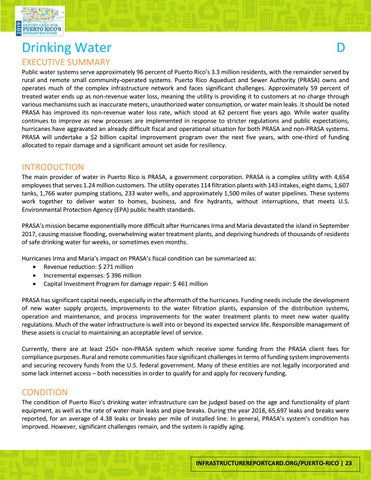Drinking Water
D
EXECUTIVE SUMMARY Public water systems serve approximately 96 percent of Puerto Rico’s 3.3 million residents, with the remainder served by rural and remote small community-operated systems. Puerto Rico Aqueduct and Sewer Authority (PRASA) owns and operates much of the complex infrastructure network and faces significant challenges. Approximately 59 percent of treated water ends up as non-revenue water loss, meaning the utility is providing it to customers at no charge through various mechanisms such as inaccurate meters, unauthorized water consumption, or water main leaks. It should be noted PRASA has improved its non-revenue water loss rate, which stood at 62 percent five years ago. While water quality continues to improve as new processes are implemented in response to stricter regulations and public expectations, hurricanes have aggravated an already difficult fiscal and operational situation for both PRASA and non-PRASA systems. PRASA will undertake a $2 billion capital improvement program over the next five years, with one-third of funding allocated to repair damage and a significant amount set aside for resiliency.
INTRODUCTION The main provider of water in Puerto Rico is PRASA, a government corporation. PRASA is a complex utility with 4,654 employees that serves 1.24 million customers. The utility operates 114 filtration plants with 143 intakes, eight dams, 1,607 tanks, 1,766 water pumping stations, 233 water wells, and approximately 1,500 miles of water pipelines. These systems work together to deliver water to homes, business, and fire hydrants, without interruptions, that meets U.S. Environmental Protection Agency (EPA) public health standards. PRASA’s mission became exponentially more difficult after Hurricanes Irma and Maria devastated the island in September 2017, causing massive flooding, overwhelming water treatment plants, and depriving hundreds of thousands of residents of safe drinking water for weeks, or sometimes even months. Hurricanes Irma and Maria’s impact on PRASA’s fiscal condition can be summarized as: • Revenue reduction: $ 271 million • Incremental expenses: $ 396 million • Capital Investment Program for damage repair: $ 461 million PRASA has significant capital needs, especially in the aftermath of the hurricanes. Funding needs include the development of new water supply projects, improvements to the water filtration plants, expansion of the distribution systems, operation and maintenance, and process improvements for the water treatment plants to meet new water quality regulations. Much of the water infrastructure is well into or beyond its expected service life. Responsible management of these assets is crucial to maintaining an acceptable level of service. Currently, there are at least 250+ non-PRASA system which receive some funding from the PRASA client fees for compliance purposes. Rural and remote communities face significant challenges in terms of funding system improvements and securing recovery funds from the U.S. federal government. Many of these entities are not legally incorporated and some lack internet access – both necessities in order to qualify for and apply for recovery funding.
CONDITION The condition of Puerto Rico’s drinking water infrastructure can be judged based on the age and functionality of plant equipment, as well as the rate of water main leaks and pipe breaks. During the year 2018, 65,697 leaks and breaks were reported, for an average of 4.38 leaks or breaks per mile of installed line. In general, PRASA’s system’s condition has improved. However, significant challenges remain, and the system is rapidly aging.
INFRASTRUCTUREREPORTCARD.ORG/PUERTO-RICO | 23






